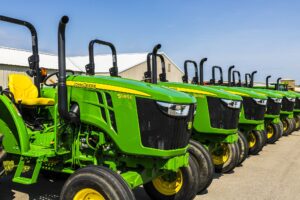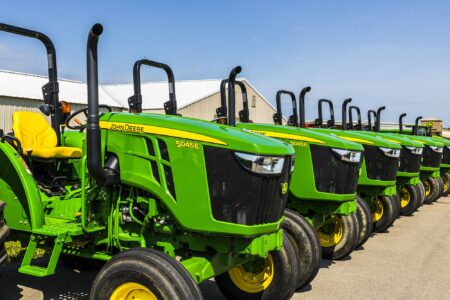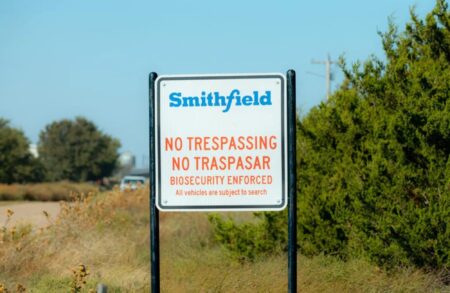Weather drives every decision in agriculture, from what to plant and when, to how supply chains function. At the Women in Agribusiness Summit earlier this fall, I moderated a panel on weather trends featuring these panelists:
- Bill Kirk is founder and CEO of Weather Trends International, operating as WeatherTrends360, which specializes in AI year-ahead weather down to the mile and seasonal sales forecasting. If a hotter-than-usual summer is expected, Kirk’s company can advise retail clients, such as Tractor Supply and Target, to stock more air conditioners and fans. The company also offers FarmCast, a subscription-based year-ahead weather forecasting report for farmers.
- Natalja Skuratovic is a senior account executive at EarthDaily, which delivers high quality data and analytics on crop conditions and health for the agriculture industry, providing insights to customers in the agribusiness, finance, insurance, and food and beverage sectors.
- John Coleman is managing director of agricultural origination at Munich Re Trading, a subsidiary of global reinsurer Munich Re that provides weather, crop-yield, and natural catastrophe derivatives for the agricultural industry.
What’s the Forecast?
Kirk said while examining the U.S. forecast is important, in today’s market, it’s just as important to analyze what’s happening in the rest of the world. “Brazil is having an awesome weather year,” he said, which affects prices around the globe.
Kirk predicted spring 2026 will be the coldest in three years and the wettest in 14 in Brazil. Because of that, “We are projecting an 8% increase in yields on top of last year’s record full-season Brazil crop,” he said. “For the safrinha second crop, we’re projecting another record — up 2.6% over this year’s record crop. This is ultimately bearish news for any hope of a major spring price rally.” Safrinha is a Portuguese word referring to the second corn crop, which is Brazil’s largest crop, accounting for roughly 76% of total production, according to USDA. It is planted between January and April after soybeans are harvested, and harvested between June and September.
The U.S. Corn Belt will have the coolest spring in seven years but the driest in three, with a possible May freeze in the U.S., Ukraine, and northeast China, Kirk said. ”I’m a little bit bearish going into spring. You might see some upward price movement in May, but there will be a great deal [of grain] coming out of Brazil by March or April, so the prices aren’t going to go that high,” he predicted.
Despite an overall drier summer in 2026, he said the U.S. crop yield should still be “decent,” which won’t do much to support higher prices. “In 2027 we’ll probably start to see some kick in commodity prices, but we’ll have to get through next year,” he said.
Long-range forecasting can help farmers decide which seed to plant, determine which inputs may be most important, and prepare for potential pest and disease problems, Kirk said. For example, “In Pennsylvania in 2026, we’re looking at the wettest summer in seven years, so there’s concern for tar spot,” he said. “That’s real information farmers can act on. If you’re in the Midwest, and it’s hot and dry next year, you might be less worried about that type of fungus and worried about other things.”
AI Forecasting
The panelists agreed that AI is a critical part of the forecasting picture, but it’s not the answer to every question.
“AI is making everything fast. It’s really good at processing lots of data and getting answers in seconds that used to take hours,” Kirk said. “But it’s not necessarily more accurate, so be careful.” He said that’s why meteorologists and other experts are still crucial for accurate forecasting.
Skuratovic agreed. “Ensuring that accuracy of data is really a big job for companies like ours, using the right tools and the right people to configure, calibrate and clean the data thoroughly to make it analysis-ready, thus eliminating false positives and false negatives,” she said.
AI can help agribusinesses and farmers dig through mountains of data to find the items most important to their business or operation. “Knowing what’s happening in the field without having too many distractive signals will help farmers to hit prices at the right time and to better estimate crops’ in-seasons in order to understand how to better market their grain,” Skuratovic said.
Beyond the Field
While farmers may have access to crop insurance to help offset losses, Munich Re Trading provides weather, crop-yield and natural catastrophe derivatives to all other agricultural businesses in the supply chain.
Coleman said the company offers parametric products that use data on weather, crop yields, and natural disasters to drive payouts rather than using adjusters and claims processes like traditional insurance. “Our message is not risk forecasting, but more risk mitigation. We work with everybody else in the supply chain who’s not the farmer on how they can hedge their risk on the size of the crop locally,” he said.
For example, he said, if a farmer facing a yield loss is part of a co-op, the co-op would lose the revenue that crop would have generated. “Our product is geared towards the co-op to hedge their risk, [crop volume risk locally] which they can’t hedge using any other products available on the market,” he said.
Forecasting can also benefit the supply chain when it comes to transportation and exports, Skuratovic said. If weather will cause a harvest to be later than usual, for example, those booking freight need to take that into consideration. She pointed out that in parts of Europe, shipping has also been greatly affected by wars and blockages of water routes.
Coleman said his company works with shipping companies whose barges are affected by things like low river levels due to lack of precipitation. “This gives businesses the opportunity to hedge out these very, very unique risks along the supply chain,” he said.


:max_bytes(150000):strip_icc()/Markets-7-Corn-up-soybeans-down-3-8a19ee3772234e24930af71711d04827.jpeg)

:max_bytes(150000):strip_icc()/IMG_2890-1536x1152-3e525ec1627340a18d71eca413e6e1d6.jpg)


:max_bytes(150000):strip_icc()/Farmer-at-work-under-storm-1091385068_1256x838-721ac36a3dd941cc9e3c3949d1d2405b.jpg)

:max_bytes(150000):strip_icc()/28413combineunloadingsoybeans_soybeans-b44cae9865ea442e80599d59f4d88991.jpg)
